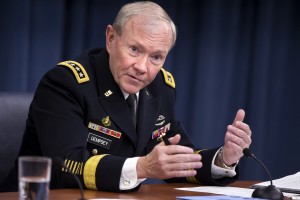STUTTGART, Germany (AP) — North Korea’s bellicose rhetoric and threats, while worrisome, appear to fit a decadeslong pattern of provocation followed by uneasy peace, the top U.S. military officer said Friday.

“I wouldn’t say I see anything to lead me to believe that this is a different kind of cycle,” Gen. Martin Dempsey, chairman of the Joint Chiefs of Staff, said in an interview after speaking at a ceremony installing Gen. David Rodriquez as chief of U.S. Africa Command.
Dempsey’s remarks suggested that he does not believe the situation is headed toward war, despite a series of threatening statements by the North, including a declaration this week that its military is authorized to launch a nuclear attack on the United States.
Other U.S. officials have said this week they see no North Korean preparations for large-scale military action, but White House spokesman Jay Carney said a missile launch wasn’t unexpected.
“We would not be surprised to see them take such an action,” he told. “We have seen them launch missiles in the past.”
Dempsey called the North’s nuclear threat “just reckless” and contrasted such talk with what he described as measured moves by the U.S. to deter the North and to reassure South Korea.
“Our moves have been largely defensive and exclusively intended to reassure our allies,” he said, referring in part to the announcement that a more advanced missile defense system, designed to knock down hostile missiles in the upper atmosphere and beyond, would be deployed to Guam, a U.S. territory in the Pacific that hosts U.S. forces.
The U.S. also has made a point of highlighting aspects of an annual U.S.-South Korean military exercise that included a practice bombing run over South Korea by B-2 stealth bombers, as well as flights of B-52 bombers and the presence of F-22 stealth fighter planes. Two of the Navy’s missile-defense ships were positioned closer to the Korean peninsula, and the Pentagon has announced plans to beef up its U.S.-based missile defenses.
Dempsey said he does not foresee any further U.S. military moves in the near future.
Dempsey said he has talked in the past few days to the commander of the 28,500 U.S. troops in Korea, Gen. James Thurman, about the safety of forces and their families. He said Thurman has made no recommendation to evacuate any military dependents.
The U.S. and South Korea have been at odds with North Korea for more than a half century. The two sides fought a three-year war in the 1950s that ended in a truce, and the North has long complained that the U.S. intends to overthrow its leaders.
Washington is treaty-bound to come to South Korea’s defense if Seoul is attacked.
North Korea responded with fury to U.N. sanctions following its third nuclear test Feb. 12, and to the U.S.-South Korean military exercise known as Foal Eagle. Among other statements, it has threatened a nuclear strike against the U.S., declared that it has scrapped the Korean War truce, blocked South Koreans from entering a jointly run industrial park and announced that it will takes new steps to produce more fuel for nuclear bombs.
Despite downplaying the threat of imminent war, Dempsey said there is no room to be casual about the current tensions on the Korean peninsula. He noted, for example, that the North’s threat to launch a nuclear attack on the U.S. “is new” and is worrisome, given the North’s development of ballistic missiles as well as nuclear devices. He said it is not clear that they have reached the point where they can fit a nuclear warhead atop a missile that could reach distant targets.
“The combination of that makes it very reckless” to threaten a nuclear attack, he said.
Asked how the U.S. is dealing with that, he said, “We’ll live up to our alliance obligations and protect our national interests, and that’s not being bellicose, that’s being very matter-of-fact.”
Dempsey said another troublesome factor is the North’s young leader, Kim Jong Un, who came to power after his father’s death in December 2011 and is a grandson of North Korea’s founder, Kim Il Sung. He said U.S. officials do not know who in his inner circle influences Kim.
“Though we’ve always said that North Korea has been a bit opaque to us, in the past we’ve understood their leadership and the influencers a little better than we do today,” he said. “And so the extent to which this cycle (of provocation) is a little more unpredictable, it’s because of him. We know less about him. But the pattern is very similar.”
Dempsey said that in preparation for a trip to Beijing in a few weeks, he recently spoke by phone to his Chinese counterpart about the North Korea problem, among others, and that this will be on the agenda when he makes his first visit as Joint Chiefs chairman.
“What I’m not going to do is go over there and deliver the traditional talking point of: ‘You need to get your southern neighbor under control,'” he said, adding that it’s pretty clear China cannot compel North Korea to act differently.
“I would rather take the opportunity to gain a little deeper understanding of what are the Chinese issues” with the North Koreans, he said.




